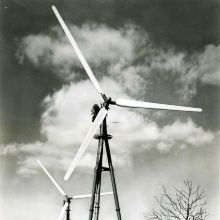The Stuttgart Chair of Wind Energy (SWE) is anchored as a chair at the Institute of Aircraft Construction of the Faculty of Aerospace Engineering and Geodesy at the University of Stuttgart. The SWE is the first university chair for wind energy in Germany, was founded in 2004 and is based on a foundation by Dipl.-Ing. Karl Schlecht, founder of Putzmeister AG, Aichtal. The use of wind energy and other renewable energy sources is actively promoted through cooperation within the university, with companies, universities and research institutions. Prof. Po Wen Cheng has been head of the chair since 2011. In research, the SWE concentrates on understanding the systems of wind turbines. The overriding research objectives are to increase the reliability and further reduce the energy production costs of turbines that feed wind power into the international grid.
Chronik
- 1942
-
Ulrich Hütter is doing his doctorate in Weimar on "Contribution to the creation of design principles for wind power plants".
- 1944
-
Dr. Hütter is appointed lecturer for "Fluid Mechanics and Flight Mechanics" at the Technical University of Stuttgart.
- 1950er
-
Dr. Ulrich Hütter works as chief designer at the company Allgaier in Uhingen, Baden-Württemberg. There he developed the legendary WE-10 wind turbine.
- 1952
-
The company Allgaier moves into a test site near Schnittlingen on the Swabian Alb to test its wind turbines.
- 1953
-
Renewal of Dr. Hütter's teaching assignment.
- 1957
-
The original model of modern wind turbines is Hütters StGW-34 turbine, 34m rotor diameter, 100 kW power, equipped with rotor blades made of glass fibre reinforced plastic (GFK), blade angle adjustment, pendulum hub, el. wind tracking.
- 1965
-
Dr. Hütter is appointed professor of aircraft construction at the Technical University of Stuttgart. He heads the Institute of Aircraft Design until 1980.
- 1970er
-
The Institute of Aircraft Design resumes research in the field of wind energy. A modern 300 kW turbine, the WEC-52 with a rotor diameter of 52 meters, is planned for Voith, Heidenheim. This system will also be tested and operated on the Schnittling test field.
- 1980
-
Emeritus Prof. Dr. Ulrich Hütters.
- 1980er
-
The aerodynamic design for the GROWIAN rotor blade is carried out at the Institute of Aircraft Engineering.
At the Institute for Aero- and Gasdynamics (IAG) the single blade wind turbine FLAIR (FLexible Autonomous I-Blade Rotor) is developed.
- 1981
-
Publication of the "Stuttgarter Profilkatolog I" with profiles for wind turbines by Dieter Althaus and Franz Xaver Wortmann at the Institute for Aero- and Gasdynamics.
- 1983
-
As part of a German-Brazilian research agreement with DFVLR Stuttgart (now DLR), a 25-metre plant with an output of 100 kW, the DEBRA-25, is being developed.
- 1984
-
Dipl.-Ing. Heiner Dörner takes over the lectures of the "Freifahrenden Turbinen, Windenergie" as elective lecture in the 8th semester of the aerospace engineering course at the institute. Under his direction, numerous student research projects and diploma theses are written on the subject of wind energy, and more than 700 students take an "examination" with him.
- 1987
-
Spin-off of the engineering company Aerodynamik Consult (ADC) by former aerospace students and Akaflieger of the TH Stuttgart. Development of calculation tools for aerodynamics, lightweight construction and fibre composite technology.
- 1992
-
DLR is partially withdrawing from wind energy research. Former employees such as Jens-Peter Molly and Henry Seifert move to the newly founded German Wind Energy Institute (DEWI) in Wilhelmshaven.
- 2004
-
The Endowed Chair of Wind Energy (SWE), donated by Karl Schlecht, starts its work in January under the direction of Prof. Dr. Dipl.-Ing. Martin Kühn. This is the first chair for wind energy in Germany.
- 2011
-
Prof. Po Wen Cheng takes over the management of the chair.


